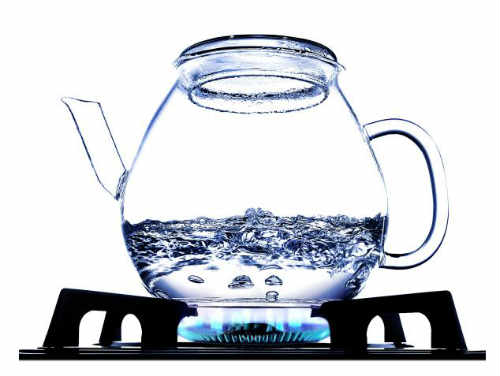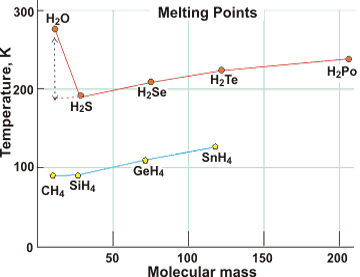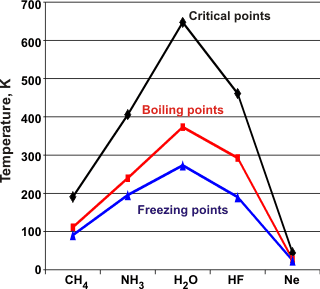The second substantive lecture we had at the Maury project was on the water column, that is, what makes water move or not move in a given area from the top to the bottom of the ocean? As I started writing up my notes, I realized that there was a serious concept that the Maury lecturers rightly assumed that science teacher would know thoroughly, but which I find that most students and many adults do not: why hydrogen bonding in water makes water behave dramatically differently from similar hydrogenated compounds, and is responsible for life in its present form on earth. (While other forms of life in colder environments are easily imaginable, there is a natural bias to assume that all other forms of life must be like us and must therefore be based on water.)
If we compare water with similar molecules–that is, molecules from column VIA of the periodic table that can bond with two hydrogen atoms, we see that water freezes and boils at a much higher temperature than any of them. This is clearer if we look at a graph of the boiling points of similar substances:
I’ve seen some periodic tables replace the old number of the columns with numbers simply going straight across the upper part of the periodic table. I don’t have a good feel as to whether the old numbering system is still used. It’s still in most of the periodic tables I’ve seen. If you have a table with only a single Arabic number on it, that VIA corresponds to column 16. If you really want to know why there’s this discrepancy, email and I’ll discuss it further with you. But you better love d-orbitals and understand their place in the structure of the periodic table!
For similar compounds (H₂X, where X is a member of column of the periodic table), the trend is upward as temperature increases. Inversely, the boiling point decreases as temperature decreases. But the predicted point from the graph where water should boil, if it behaves like similar compounds, is about 200°K (K is Kelvin, a temperature scale identical to Celsius/Centigrade except that it starts at 0°K [absolute zero, where all motion within the atom ceases] instead of at -273°K, where Celsisus starts). That’s about a hundred degrees below zero, whether you’re using Fahrenheit or Celsius. Water’s observed boiling temperature, however, is almost 200°K higher than predicted. To put that in context, that’s almost twice as big a temperature range as that between the temperature at which water freezes and where it boils.
The graph is a good one because it also compares water to the XH₄ compounds of column IVA of the periodic table. That group has an even lower boiling temperature than the H₂X family of which water is a member. And look at methane (CH₄) whose boiling temperature is lower than the trend. There’s obviously something special about water.
Let’s take a look at the freezing temperatures as well. Here’s another graph comparing comparable to the first (freezing and melting points are the same thing, really, and just depend on whether you’re looking at a liquid going to a solid [freezing] or a solid going to a liquid [melting]):
Once again, water has a much higher freezing/melting temperature than any of its column VIA fellows. Here, the difference isn’t as pronounced as with the boiling temperatures, but it takes a lot more energy to melt ice than it does any other column VIA atom. And a comparison to the elements in row IVA (carbon, silicon, germanium, and tin) again show water as an outlier.
Another way of looking at this anomaly of boiling and melting temperatures is to see the difference between melting temperatures and boiling temperatures. In the following graph, you can see that water has a much bigger gap between the melting and boiling temperatures:
Why is water so different? It’s because of the hydrogen bonding we discussed earlier. To transform ice to water, or water to steam or water vapor, significant numbers of hydrogen bonds need to be broken. Further, even in warming liquid water, lots of energy needs to be pumped in simply to get the water molecules moving faster, which makes them “hotter” (this is the kinetic theory of temperature). But in liquid, if water molecules are attracted to other water molecules by hydrogen bonds, you have to get all of them moving faster, together. This obviously requires much more energy than to move a single molecule that isn’t bonded to another. Here’s a list of heat capacity, a fancy way of saying how much heat (more precisely, energy) you have to pump into a gram of a given substance to get a one-degree Celsius (1°C) in that gram of water. Water is at the top of the list:
 It takes 4.184 joules of energy to warm one gram of liquid water one degree Celsius. That’s 32 times more energy than it takes to warm lead an equal amount, 17 times the energy it takes to warm iron, and 5.3 times the amount of energy to warm granite by one degree Celsius. Moral: it takes a lot of heat to warm water. This is one of the reasons, as we’ll see, that water plays such an important role in transferring heat around our planet.
It takes 4.184 joules of energy to warm one gram of liquid water one degree Celsius. That’s 32 times more energy than it takes to warm lead an equal amount, 17 times the energy it takes to warm iron, and 5.3 times the amount of energy to warm granite by one degree Celsius. Moral: it takes a lot of heat to warm water. This is one of the reasons, as we’ll see, that water plays such an important role in transferring heat around our planet.
Note, too, that this means that you have to get a lot of energy out of the water to cool it by a degree. In other words, warm water can raise the temperature of its surroundings dramatically.
This is even more noticeable when you talk about going from ice to liquid water at 32°F (0°C or 273°K, take your pick). Ice doesn’t turn magically into liquid water when it hits the freezing/melting temperature. Instead, you have to suck 334 joules (the measurement of energy) out of the water before it will freeze. Compare that to the 418.4 joules it will take to raise water to from its melting temperature to its boiling temperature. You have to pump almost 80% of what it takes you to get to boiling simple to turn the same amount of ice into water without raising its temperature.
By now, you already know why: the ice is held together by hydrogen bonds in all directions, and enough have to be broken to allow the water to pass from solid to liquid, even though the temperature does not rise. Water takes a lot of heat, one way or the other, to get it from one phase (solid, liquid, or gaseous) to another.
Finally, let’s look at what happens to go from liquid water at the boiling temperature (212°F, 100°C, or 373°K). Simply to go from liquid to gas requires 2260 joules, almost 5.5 times the amount of energy to raise liquid water’s temperature from the freezing temperature to the boiling temperature. Again, the reason is the hydrogen bonding. It was bad enough getting enough hydrogen bonds in ice to break to turn ice to water. Here, it’s worse, because you have to break every single hydrogen bond to get water at the boiling temperature to water vapor.
This characteristic of water explains its unusually high boiling and melting temperatures compared to similar molecules. It’s the single most important factor in getting air and water to move around the earth.
Note that we’ve been only talking about putting energy into the system to change from solid to liquid, or from liquid to gas. The opposite happens when you run the other way. If you’re freezing water, you’ll get 334 joules/gram given up to the environment as water makes the transition from liquid to solid (ice). Similarly, you’ll get 2260 joules given up for every gram of water that condenses from vapor to liquid, such as, for example, when rain falls. All that energy, stored in the water, gets shoved back into the environment. That’s all you have to know for now, but keep it in mind when we start looking at weather and at sea currents.



